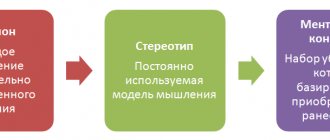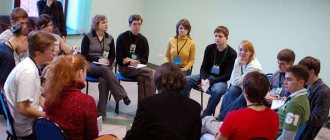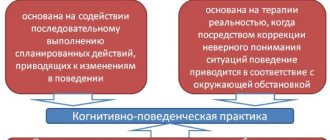For children, play is one of the main tools for development in life. With its help, they learn to interact with other people, develop intellectually and physically, explore the world, and broaden their horizons. And most importantly, they do it all in an interesting way without coercion. Game therapy (IT) is a psychological tool aimed at working with mental disorders in people of all ages through participation in a certain game.
What is "play therapy"? A little history
Back in 1913, Sigmund Freud decided to use this technique to work with children. He was guided by the fact that a child shows his activity through play and thereby reveals passive sources of experiences.
Then, almost 20 years later, his example was followed by Melanie Klein, who preferred to take the role of an observer in this type of therapy. In her work, she practiced bringing awareness to children of their own behavior and state through play.
Anna Freud went against her in 1946, who believed that in play therapy the doctor should occupy a dominant position, in principle, like the patient’s parents, whom she actively involved. In addition, she used dolls that interpreted the people around the child, and through them she resolved conflict situations, behavioral problems and life relationships.
Play therapy began to gain momentum in the forties. Various techniques, varieties and directions of this method of treatment have appeared. And since then, IT has only improved because it has good practice.
How does it work
Play is the main activity of a child, from birth to adolescence. With its help, he receives information about the world around him, about the methods of interaction between people and objects, and also in the game thinking, fantasy, volitional and other qualities are formed.
Numerous studies prove that learning through play is one of the most effective methods of interacting with children of different ages, normotypical and with developmental disabilities.
By involving the child in the game, the specialist gets the opportunity to “look” into the inner world of the child, who unconsciously transfers his feelings, experiences or fears to the characters in the game or “plays out” situations that worry him. This technique is well known to most modern parents, who, using this simple method, determine whether the child is comfortable in kindergarten, school, among new friends, and so on. To do this, it is enough to invite him to play “in kindergarten” or “school” and carefully observe his behavior, remarks and emotions.
The goal of play therapy is to help a child cope with some traumatic events, even if he is not aware of them or does not perceive them. A specialist can assess the child’s emotional and mental state and help him cope with negative emotions, fears, anxiety, incomprehensible but disturbing situations, other feelings, or teach him acceptable ways to express his emotions, interact with others and perform certain everyday skills.
The main rule of play therapy is its comfort for the child. He should feel confident and free; this is the only way to learn about his internal state and help him cope with problems.
Goals of play therapy
- Development. In this vein, classes can be conducted not only with children who have any psychological disabilities, but also with healthy ones. Using this type of therapy, a psychologist will help you unlock your potential and develop certain skills.
- Correction. Game therapy in this case is again not aimed at treating a disease, but at eliminating some small behavioral barrier.
- Psychotherapy. Elimination of anxiety, fears, assistance in overcoming severe psycho-emotional problems, for example, parental divorce, the birth of a younger child.
It’s more fun, interesting, and easier for children to perceive information in a playful way. A doctor who provides child psychotherapy through play is a specially trained play therapist. During a therapeutic session, the child brings a lot of personality into the playing field, so it is very important for the therapist to be able to see those situations that concern the child. And it is also equally important to be able to play out disturbing moments during the lesson so that the patient’s feelings go away.
The fact is that a child does not always know how to independently recognize an internal conflict, much less come to the doctor, sit in a chair and talk about it. As a rule, this problem manifests itself through disobedience, aggressive behavior, anxiety and other disorders. But on the other hand, a child can demonstrate all his anxieties during play, since it is his leading activity. Therefore, a lot depends on the play therapist. He must be able to “read” and evaluate situations during the game, and help the patient find mental balance.
On practice
For preschoolers
For young children, play activity is the leading one. Therefore, most activities in kindergarten are based on it.
What kind of games and exercises can be used for preschool children aged 3-4 years:
If at 3-4 years the main task of play therapy is training and development (of the same cognitive abilities), then at 6-7 years it acquires a more diagnostic and corrective nature, allowing the correction of psychological problems.
For children 6-7 years old:
For problem children
Play therapy in childhood can effectively treat all kinds of personality and behavior disorders.
For children with disabilities
Play for children with disabilities often remains the only way to express themselves due to their specific characteristics. At the same time, it allows specialists to help treat the underlying disease and develop the child as much as possible.
Recommended: finger (Bird, Horned Goat, Bell), with waste material (laces, clothespins, beads, buttons), educational (construction set, mosaic, puzzles).
With anxious children
Research shows that play therapy has a harmonizing and corrective effect on the level of anxiety in children and on their mental state in general.
Relaxation and breathing exercises: Fight, Balloon, Gift under the tree, Piper, Barbell. For relaxation: Dancing hands, Waterfall. To develop a sense of trust and self-confidence: Bunnies and elephants, Change of rhythms and many others.
For preschoolers with aggression
Children become aggressive because they have nowhere to throw out the negative energy accumulated as a result of psychological trauma. Play therapy helps them with this.
To relieve muscle tension: Ball, Circus, Chase away Baba Yaga, Caricature, Let's make a fairy tale, Glue rain. For such children, outdoor play activities will also be useful: Two rams, Tukh-tibi-duh, Ask for a toy (in verbal and non-verbal versions).
Indications for the use of play therapy and when is play therapy effective?
For children, especially young children, everything that happens around them is a game. Therefore, it cannot be said that there should be some indications for it, since for children this is the main form of leisure. It is during the game that children are always in a good mood, open to interaction and do not regard such pastime as something unpleasant for themselves. But from the point of view of psychological deviations, IT will help in the following cases:
- isolation and unsociability;
- the presence of hidden and obsessive phobias;
- disobedience or superobedience;
- bad habits (nose picking and others);
- establishing relationships (with parents, with brother, etc.);
- aggressive behavior;
- self-harm (pulling out hair, eyelashes, biting lips, etc.);
- retarded speech development;
- stressful situations;
- problems with reading, as well as academic performance in general.
Types and methods of play therapy
In order for the game to take place, rules for its conduct and toys, if necessary, are necessary.
Depending on the psychological principles on which the rules of the game are based, the following types of play therapy are distinguished :
- IT in psychoanalysis;
- game therapy in domestic psychological science;
- primitive IT;
- play therapy for relationship building;
- IT response;
- play therapy with unstructured material;
- individual IT;
- group play therapy.
IT methods depend on toys or additional props that are used during therapy. Since there are many options, it turns out that there are many methods, but we will highlight the main ones.
- Sand
- Fairy tale therapy
- Active
- Passive
- Puppet therapy
- Liberating
- Structured
- Relationship therapy
- Chess
- Musical
According to some names, their essence becomes obvious. But I would like to clarify that the meaning of the active method is that the game therapist plays the game along with the patient or is its leader. In passive mode, he takes on the role of observer. In the liberating and structured methods, the goal is to play out the situation that is gnawing at the child, as well as the release of emotions. Relationship therapy places the emphasis on what is happening here and now in the office, rather than on the patient's past. There are various play therapy programs for this purpose.
Principles, methods, techniques
Basic principles of play therapy:
- gaming activity is not an entertainment event, but a means of diagnosis, correction, training and auxiliary treatment;
- the topic of the game is significant for the play therapist and interesting for the client;
- activation of independent initiative of participants;
- directive and non-directive game components complement each other;
- the relationship between spontaneity and specific focus is determined not by the age of the participants, but by the characteristics of their psyche;
- gameplay can be directed, but not commented on by adults;
- psychological and psychotherapeutic influence is carried out through the characters.
Basic methods:
- suggestion in reality;
- auto-training;
- imagotherapy;
- independent and role-playing games;
- improvisation.
Main directions:
- sand play therapy;
- fairytale therapy;
- puppet therapy;
- chess;
- musical;
- motor;
- role-playing;
- dramatic.
Depending on the directions, the techniques used are determined:
- sand drawing;
- writing and playing fairy tales;
- sculpture and design using clay, alabaster, wax, soap, wood, wire, metal, paper, boxes and even garbage;
- games with dolls;
- chess helps to realize and fulfill life's tasks (according to Gestalt therapy, each chess piece, creating its own tactics and each move demonstrates some new aspect of personality);
- games involving music and dancing are a new method of adaptive education for preschoolers with mental retardation;
- stage productions, when the character of the hero reveals the actor himself, his fears, experiences, and complexes.
Depending on the problem at hand, a play therapist can choose one technique to work with a person. For example, for children with mental retardation, the most effective option would be music and dance games. But most often, specialists combine methods, directions and techniques to achieve a more comprehensive result.
Game therapy products
In IT there must be a leader - an adult. As a rule, this is either a play therapist or a parent. They provide the means that allow the patient to open up. They are selected based on medical history and individual characteristics, and can be as follows:
- dancing;
- modeling;
- outdoor games;
- drawing;
- games with dolls;
- sand games;
- design;
- role-playing games.
In addition to the means described above, there may be any others that allow you to liberate the child and open his inner world. Their task is to model situations in which the child can resolve an internal conflict. Therefore, the use of toys and other objects helps to bring the model closer to reality and thereby identify the problem during the game.
We also recommend reading: Isotherapy - healing through creativity
Board games
Activities with children can be not only active. It is also possible to use board games. As art therapy, they contribute to the development of the child’s abilities and personal qualities. In addition, they combine play with learning. That is why conducting such classes can become a wonderful educational tool for preschoolers.
Board game therapy develops a child’s attention and visual memory, logic and intelligence, imaginative thinking and imagination. As a rule, several people should take part in such classes at once. In this case, art therapy games promote interaction between children. By obeying the proposed rules, preschoolers learn proper communication with each other, patience while waiting for their turn to make a move, empathy for their opponents, as well as accepting with dignity not only victories, but also defeats. Thus, board games in art therapy allow you to correctly form a child’s personal qualities.
Among the main advantages of such activities is the lack of need for playgrounds and complex equipment. For them you only need a table and all the necessary items (cubes, chips, cards, etc.). Such games have the following advantages:
- teach preschoolers to recognize and then remember a wide variety of phenomena and objects, develop the child’s attention and expand their vocabulary, doing this in an interesting and colorful way;
- prepare the baby for life by offering him certain problems, solving which the baby develops his skills and abilities, gaining life experience;
- help improve reaction speed, dexterity, coordination and eye.
For example, the board game “Shopping Therapy”. It is intended for girls. Her goal is to make as many purchases as possible while spending as little money as possible. During the game, the participants will have to take turns making moves. This will allow them to enter the boutiques of the shopping center. It has two floors. At the first of them, you are offered to buy various outfits, as well as choose accessories to go with them. The second floor is the entertainment area. You can get here by going to the “elevator” field. The participant who finds herself on the second floor must skip one lap. Here, when entering the fields of restaurants and bars, she will have to pay a certain amount. The one who is lucky finds himself in the field of luck. Here you can win a certain amount of prize money. The winner is the participant who managed to buy the most goods while spending the least money on them.
Thus, "Shopping Therapy" is a game that is an interesting and exciting entertainment. Here, each of the participants will feel as if she was in a real shopping center, where she is offered to buy everything she wants for money.
The game package includes the playing field itself, as well as 60 red and 24 yellow tokens. They come with 4 passports, 60 banknotes, a move die, 72 cards, and 20 Excursion cards. The game rules are also included.
Play therapy for preschool children
The time when children start going to kindergarten is always a stressful period in their lives: a change of permanent residence, an increase in the number of people around, prolonged separation from parents, early rises and other moments unsettle the child. All this can provoke aggressive behavior, increased anxiety, disobedience, protest and other behavioral deviations. In such situations, the use of play therapy is more necessary than ever.
Starting from the age of two, you can begin to correct the baby’s behavior. During the game:
- emotional balance is achieved;
- behavior is corrected;
- social skills develop;
- gaps created by the family are eliminated.
A very important point is that the child should be comfortable and interested during the game, then the result will not be long in coming, and he will learn:
- make friends with other children;
- be aware of your “I”;
- respect others and their selves.
When visiting the kindergarten, every day the baby is in the same conditions, which give rise to fears and complexes. IT is aimed at working through them, understanding them and getting rid of them.
Tasks
The main game therapy function of the game is to identify and correct deviations in behavior and psyche in a relaxed environment. To implement it, depending on the specific problem, specialists solve several problems at once:
- restoration of trust in others, assistance in social adaptation, development of the communication sphere, optimization of relationships in the systems “child - parents”, “child - adults”, “child - other children” (similar schemes are being developed for adults);
- deactualization of phobic manifestations;
- demonstration of various ways to solve difficult life situations;
- correction of deformations in the formation of the “I-concept”;
- correction of negative character traits and behavioral deviations;
- treatment of borderline personality and behavior disorders;
- relief of psychological suffering;
- increasing self-esteem, getting rid of internal complexes;
- creating favorable conditions for the development of speech, thinking, memory and other cognitive abilities.
To summarize all these tasks, specialists using play therapy diagnose the problem and either correct it (in psychology), or treat it (in psychotherapy), and also teach.
Game therapy as a diagnostic tool:
- clarifies personality characteristics;
- clarifies relationships with the outside world in general and specific people in particular;
- reveals childhood psychotraumas at the sensorimotor level;
- demonstrates involuntary expression of oneself.
Game therapy as a means of developing cognitive processes:
- improves speech skills;
- develops memory (you need to remember the rules of the game, your goal in it, the names of the other characters);
- demonstrates how to solve difficult life situations;
- improves thought processes;
- broadens your horizons about the world around you;
- teaches social adaptation skills;
- forms an adequate mental response to events;
- develops the ability to arbitrarily regulate activities against the background of the need to obey a general system of rules.
Game therapy as a method of psychological correction:
- adjusts the system of social relationships;
- helps to overcome personal and cognitive egocentrism and decentration towards comprehension of one’s own “I” in the game;
- promotes understanding of such concepts as equality and partnership, cooperation and cooperation,
- provides the opportunity for personal development;
- organizes new methods of orientation in conflict situations;
- adjusts the system of life values and prioritization;
- corrects negative character traits and deviant behavior;
- eliminates psychological and behavioral barriers.
Game therapy as a method of psychocorrection and as a means of developing cognitive abilities is a tool of psychology. In psychotherapy it is used as one of the auxiliary treatment methods:
- eliminates bad habits;
- helps overcome worries and fears;
- relieves internal tension;
- solves severe psycho-emotional problems;
- effective in treating autism;
- increases frustration tolerance;
- gradually develops and strengthens disturbed mental processes.
Sand play therapy
Sand play works in several ways and eliminates many problems. Such a pastime seems simple, but in this simplicity lies the effect.
- Irritability, tearfulness, and aggressiveness are relieved.
- Fantasy develops.
- Social connections are being built.
- Coordination improves.
- Fine motor skills are stimulated.
- The mood lifts.
Thanks to modern technologies, you can play not only in the classic sandbox, but also in special backlit sand tables. Such therapeutic leisure allows you to create in real three-dimensional space. A child, playing with sand, feels like the creator of the whole world.
Who is better for a child to play with?
It is impossible to answer this question unambiguously. It all depends on the goals described above. If it is necessary to reveal potential or slightly correct behavior, then it will be comfortable and adaptive to do this with parents. After all, they are the ones who know their baby better than anyone else and will find an approach to him. And the child will be more comfortable playing with relatives. Regular trips to the office with a “Psychologist” sign can themselves cause stress, which is unnecessary if the baby is just a little capricious, for example.
Parents cannot always cope with psychological disorders on their own due to many factors: subjectivity, lack of appropriate education, time, desire, and others. Therefore, in such cases, it is better to contact a play therapist who, if necessary, will involve both mom and dad in the game or teach them how to play at home.
Different games for different purposes
Unfortunately, there is no one universal game that would allow you to get rid of childhood problems. The choice of game depends on the source of the disorder and its depth. It is best if a psychologist selects suitable leisure time. But there is no harm from games, so you can use the recommendations described below.
Several conditions must be met for the game to be successful.
- Such a pastime should be interesting not only for a child, but also for an adult. Children always sense insincerity. And if they know that their parents play with them because they have to, and not because they want to, then the entire therapeutic effect may come to naught. The sincere pleasure of all participants is the key to success.
- The game should be spontaneous. For kids this is of particular importance. If a child plays according to some schedule, then for him it will not be entertainment, but work.
- The game must be voluntary. In general, this is obvious from the previous paragraphs. Entertainment under pressure is no longer such.
Games to improve psychological well-being
Children feel calm when they know that someone needs them and is interesting. The easiest way to show this is through the following well-known games:
- blind man's buff;
- tag;
- hide and seek;
- obstacle course.
In all games, it is important to give in a little, if it is clear that the baby is not coping, to encourage and praise for success.
Games that help correct aggression
For children who show aggression, it is important to show in contrast that there is another model of behavior, and also that any dispute should end on a positive note. These games can be played from the age of two.
- War game. A child and an adult throw various safe objects at each other: pillows, wads of paper, plush toys, using shields and shelters. And they end the fight with a draw and hugs.
- Cats. The baby and the adult take turns turning together, either into kind, purring and caressing cats, or into angry and hissing ones. Instead of cats there can be dogs, hedgehogs and any other animals.
Games aimed at relieving tension and relaxation
The main goal of eliminating these parameters is a change in brain activity and physical calm.
- The sea is agitated once. The well-known game works great for distraction and relaxation. The adult says: the sea worries once, the sea worries two, the sea worries three, the sea (terrestrial, vegetable, any other) figure freeze! While voicing the phrase, the child sways as if on the waves and freezes at the last word in some position until the presenter guesses what kind of figure it is. Then the players change roles, or do the same thing again. This entertainment is suitable for children from three years old.
- Doll. The presenter tells the child to imagine that he is turning into a doll. Lists all the parts of the body that should become stiff, while pressing on them. The child freezes in one position, trying to tense all his muscles until the adult says that the baby has become a human again. He becomes glorified and softens. This game can be played from the age of four.
Games that help correct fears
If a child is worried about internal experiences and fears, it is important to show him that in any situation you can find a way out and be saved.
- Cat and mouse. An adult and a child take turns taking on the role of a cat or a mouse. The cat is sleeping, and the mouse is running around him and squeaking. He wakes up, starts hunting for the mouse, she runs away and saves herself in her hole. This game can be played from two years old.
- Bringing. One of the players puts on a sheet and becomes a ghost. With a frightening “UUU” sound, he begins to run after the other participant and if he catches them, they change roles. This type of entertainment can be used from the age of three.










